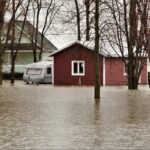A flood that impacts your area will shake any family and your community. This is not an event that most see coming, and nobody ever anticipates the amount of damage that uncontrollable water will leave after it hits a town or city.
If a torrent hit your home and left you stranded with no plan, stay calm. The article will go over a couple of things that you can do to pick yourself back up after the disaster.
1. Check-in with Friends and Family
If your extended family lives in the same area as you, make sure that you check in with them as soon as possible. Whether your family lives down the block or in a separate neighborhood, the torrential waters affect everyone.
When you are to safety, contact your loved ones. If possible, call or text them.
For those who only live with their immediate family, or live with friends/roommates, checking in is still beneficial. Keep tabs on your loved ones, whether or not they are blood-related to you. Disasters require team efforts to recover.
2. Avoid Flooded Areas Until Clean Up is Complete
Even though you’ll want to rush home again after the initial flooding is over, be patient. If you rush back in, you risk endangering yourself to polluted water and bacteria. Not only that, but you also hinder the rescue and recovery efforts of professionals.
Stay calm and wait for the all-clear. While you wait, focus on mentally and physically recovering. Make sure that you and your family/friends are well-rested and uninjured.
3. Proceed Home with Extreme Caution
Even though you’ve received the all-clear, you should still go back to your house cautiously. Government and public clean-up efforts primarily focus on public places and roads. Because of this, you can’t be sure about the state of your home.
Before entering the property, turn off your gas and electricity. You don’t want to risk an explosion or electric shock. Don’t enter your home until you have sturdy boots, protective gear, and thick clothes.
Finally, open all windows and doors, emergency patch holes, and remove whatever debris you find.
4. Ask for Help with Repairs
Even though emergency services will be necessary upon return home, they will not be enough. Asking for help is not a sign of weakness. You’ll need to reach out to professionals to get back on your feet.
Before contacting anyone, contact your private insurance provider. Check to see if either your state or the United States offer natural disaster relief aid.
Once you have the finances settled, reach out. Contact residential roofing services in states like Utah or local contractors to handle extensive repairs.
5. Stay Organized and Patient
Throughout the process, you will feel frustrated, upset, and depressed, among other emotions. Your feelings are perfectly natural. Do not try to suppress your moods or put up a front. You can cry and scream if you want to. It’s crucial, however, not to get swept away in your emotions. Otherwise, you risk delaying the recovery process.
Craft a plan and stay organized. Take deep breathes. Remember that recovery takes time, a minimum of 18 months for flood damage. You’ll get back on your feet, but it will take over a year before you feel like your life has returned to normal.
Maintain Your Faith
A torrential flood is not the end of the world: it’s a setback that requires time to heal and recover. Though this natural disaster has put a pause on your life, it should not rob you of your faith and compassion. Maintain hope, and with an organized plan, you will recover.











